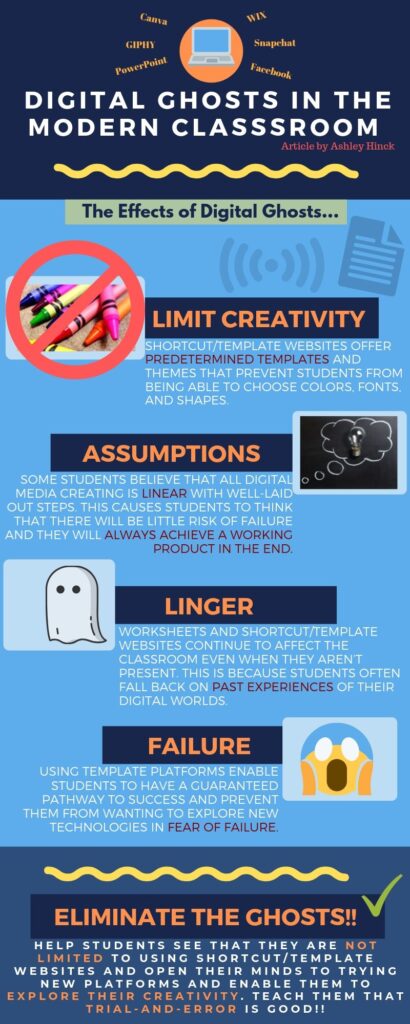I read the article “Digital Ghosts in the Modern Classroom” by Ashley Hinck. In this article, Hinck discusses how shortcut/template websites restrict student’s creativity. This is because they only offer a limited amount of preplanned template designs to choose from. These templates reduce the need for the user to decide what color or font to use, thus limiting their experimentation with technology.

Hinck also mentions how most of the students she works with assume that digital media making is straightforward and all they have to do is follow specific steps to get a guaranteed working product in the end. This is because most students are only exposed to shortcut/template websites such as PowerPoint, Facebook, or Snapchat which all have well laid out steps to follow. Rarely are students exposed to open-ended and more advanced programs like HTML and CSS, which give users more control over the final product. By sticking to these template websites, students believe they will always achieve success. Unfortunately, they end up preventing some students from wanting to explore new technologies in fear of failure.

I agree with the author’s opinion in that these shortcut/template websites and platforms discourage open-endedness and exploration. As a student, it’s a lot easier to stick to what’s familiar and known to work. I, myself, have never really left my comfort zone with technology that is unfamiliar to me. This is the reason I chose to use Canva to create an infographic depicting the article. Although Canva is mentioned in the article as being an example of a shortcut/template website, I have never used Canva and therefore wanted to experience it first hand in order to get a better understanding of it.

As discussed in the article, Canva does provide multiple templates to choose from which makes creating much easier. Once a template is chosen, you are able to edit details on the template and add images. However, many of the images offered on this website must be purchased in order to be use. Without purchasing these pictures, your options are limited. This could be a potential issue for students who can’t afford to buy multiple images online and could result in a decrease of their creative expression.
Going forward, I believe it is important to instill creativity in students’ minds, and that “trial and error” is an important part of our learning process. We need to encourage them to try different platforms in order to explore their own creativity.

